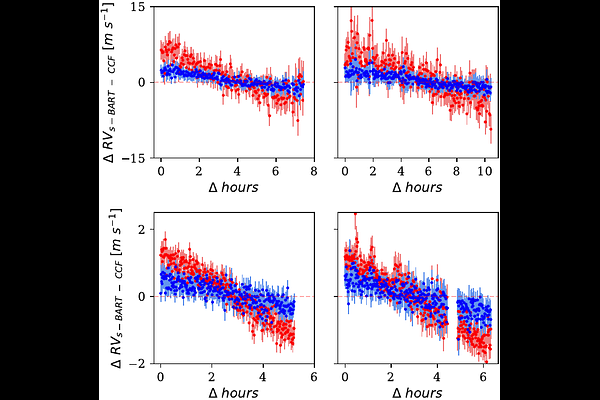A systematic bias in template-based RV extraction algorithms

A systematic bias in template-based RV extraction algorithms
André M. Silva, N. C. Santos, J. P. Faria, J. H. C. Martins, E. A. S. Cristo, S. G. Sousa, P. T. P. Viana, É. Artigau, K. Al Moulla, A. Castro-González, D. F. M. Folha, P. Figueira, T. Schmidt, F. Pepe, X. Dumusque, O. D. S. Demangeon, T. L. Campante, X. Delfosse, B. Wehbe, J. Lillo-Box, A. R. Costa Silva, J. Rodrigues, J. I. González Hernández, T. Azevedo Silva, S. Cristiani, H. M. Tabernero, E. Palle, B. Lavie, A. Suárez Mascareño, P. Di Marcantonio, C. J. A. P. Martins, N. J. Nunes, A. Sozzetti
AbstractIn this paper we identify and explore a previously unidentified, multi meter-per-second, systematic correlation between time and RVs inferred through TM and LBL methods. We evaluate the influence of the data-driven stellar template in the RV bias and hypothesize on the possible sources of this effect. We first use the s-BART pipeline to extract RVs from three different datasets gathered over four nights of ESPRESSO and HARPS observations. Then, we demonstrate that the effect can be recovered on a larger sample of 19 targets, totaling 4124 ESPRESSO observations spread throughout 38 nights. We also showcase the presence of the bias in RVs extracted with the SERVAL and ARVE pipelines. Lastly, we explore the construction of the stellar template through the 5 years of ESPRESSO observations of HD10700, totalling more than 2000 observations. We find that a systematic quasi-linear bias affects the RV extraction with slopes that vary from -0.3 m/s-1/h-1 to -52 m/s-1/h-1 in our sample. This trend is not observed in CCF RVs and appears when all observations of a given star are collected within a short time-period (timescales of hours). We show that this systematic contamination exists in the RV time-series of two different template-matching pipelines, one line-by-line pipeline, and that it is agnostic to the spectrograph. We also find that this effect is connected with the construction of the stellar template, as we are able to mitigate it through a careful selection of the observations used to construct it. Our results suggest that a contamination of micro-telluric features, coupled other sources of correlated noise, could be the driving factor of this effect. We also show that this effect does not impact the usual usage of template-matching for the detection and characterization of exoplanets. Other short-timescale science cases can however be severely affected.